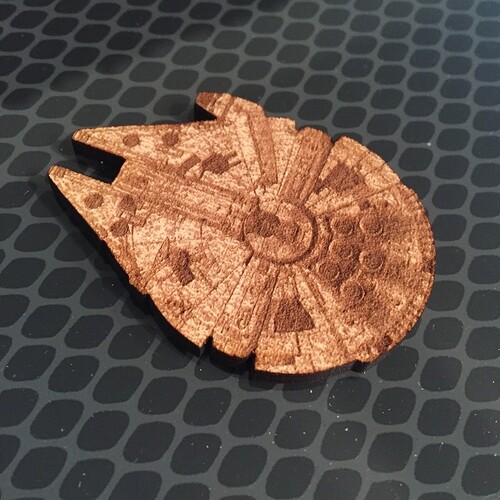Lets start at the end. I made a millennium falcon. It cut. It engraved. It finally worked. Here it is:
Now, lets go back to my first night with my Glowforge. I was excited to get started (see “Hello World! Meet Emmet”), and following the success of my founder’s ruler and my son’s pokéball drawing (see Pokéball, Gotta Forge 'Em All), I turned to our house guest and decided to engrave him a small Millennium Falcon from Star Wars. Soon after, he had to leave empty handed because I couldn’t get it to work.
Now I’m new to this whole laser world, but I’m a professional designer who can hack his way around just about anything. Add to that I’m typically the guy when someone has an issue, even if I don’t know what to do, can typically search the web and find the answer on the spot. However, this one made me feel stupid. I mean REEEEEALLY stupid. I can’t get something, that clearly everyone else on these forums with a Glowforge can do, to work. After spending a long time digging through forums for a solution, I send a lengthy email to Glowforge Support (again, sorry about that one @Dan_H, @Rita, and whoever else ![]() ) about their need to offer solid next steps for getting your own artwork through the machine because it’s really not obvious what to do once it’s all up and running.
) about their need to offer solid next steps for getting your own artwork through the machine because it’s really not obvious what to do once it’s all up and running.
I was about to throw-in the towel when I got a response from @Dan_H at 1am to my email (10pm Seattle time, I believe—Thanks for your gracious response at such a late hour). He sent me a link to: Learn By Doing: Your First Three Prints which was only slightly helpful as I’d already done most everything in there (though it seriously needs to be included in the manual or early on in the interface).
However, it did trigger one thing. I started with the SVG outline I had made and uploaded it from the home page first. Next I added the raster engrave image, lined them up by sight and suddenly everything worked. I didn’t realize why that worked at the time—I just thought, “Hmm, random fluke that I did the same things as before and it decides to work all of a sudden.” So yeah, finally able to print something again, which triggered my wife and I staying up another several hours into the early morning enjoying the Glowforge again.
Then, this morning, my wife and I tried to add a unicorn picture to a puzzle for my daughter and it was gonna take 35 min. Hmmm… Must be because it’s raster. Tried tracing it to vector and that only cut it down to a 29min task. Assuming that’s the best we could do, I started it. And then it came out all pixelated and blurry. It was strange.
Later, I came across @takitus’ comment in “SVG from illustrator turns into a raster image?”. Apparently using the “Add Artwork” button automatically treats any file you choose as a bitmap. I had been trying to add my SVG to a job I’d already uploaded rather than starting with the SVG file (which is why the order I uploaded made a difference on the falcon). It also explains why my vector trace on the unicorn puzzle came out so crappy (which I’m going to have to test out again now that I know what NOT to do).
Now, all that to say: @dan, I believe it would be a solid win for Glowforge to include some helpful instruction beyond unboxing your Glowforge and connecting to the app. I know your stress and focus is on production of a quality product and getting it into the hands of your backers, but don’t forget about what happens after your product is dropped on our porch and we turn it on—make the next steps more accessible.
Don’t get me wrong. This machine is incredible and SO worth the wait! I’m grateful to have it in my home. You guys are doing good work and I know you have a lot to deal with. Just figured while I’m sharing all the good, probably helpful to point out the weak points since I want you guys to succeed, too!
EDIT: Alright, enough with the frustrating project… Let’s get to the fun stuff: Day 2 with Emmet: It’s a Party!


